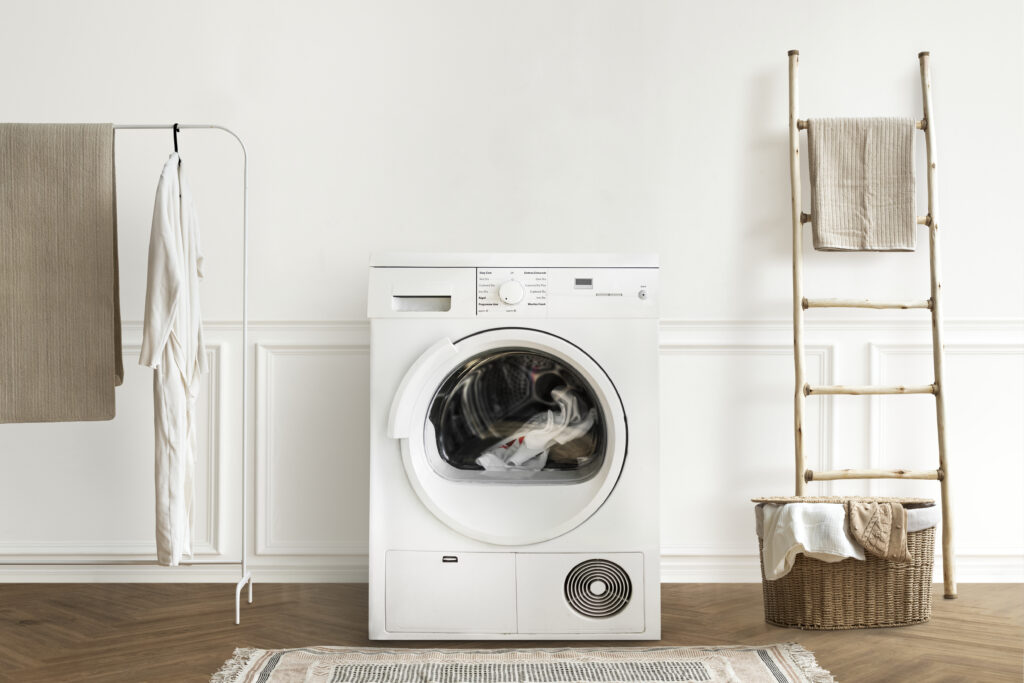One of the most important household appliances in any American home is a washing machine. However, nothing is more annoying than discovering the washer is full of water after a cycle. Don’t worry if your washing machine isn’t draining correctly; this is a common issue that can usually be resolved with a little troubleshooting.
We’ll go over the potential causes of your washing machine’s failure to drain, how to fix it at home, and when to hire a professional in this guide. These pointers will help you quickly resume your laundry routine, regardless of whether you have a front-loading or top-loading washer.
📌 Why Does My Washing Machine Not Empty? Typical Reasons
Your washing machine may stop draining water for a number of reasons. The first step in resolving the problem is identifying the underlying cause. The most frequent offenders are as follows:

1️⃣ Blocked or Clogged Drain Hose
Water is transported from your washer to the laundry sink or drainpipe via the drain hose. Water cannot exit the machine if it becomes clogged, kinked, or bent.
- Blocked Pump Filter
Lint, hair, coins, and other small debris are captured by the tiny pump filter found in the majority of contemporary washing machines. The machine may not be able to drain if this filter becomes clogged.
3️⃣ Bad Drain Pump
During the drain cycle, the drain pump forces water out of your machine. Your washer won’t drain correctly if it’s damaged, jammed, or experiencing electrical problems.
4️⃣ Blockage Within the Drum
Occasionally, tiny bits of cloth, buttons, socks, or other items may obstruct the drum’s internal drainage system.
5️⃣ Door lock or lid switch issue
A malfunctioning lid switch on top-load washers may prevent the drain cycle from commencing. A broken door lock on front-loading washers can stop the machine from draining.
6️⃣ Clogged Drainpipe or Standpipe
Water may back up and remain in the washer if the drain that your washer empties into is clogged or moves slowly.
7️⃣ Wrong Load Balance
Bulky or overloaded items, such as comforters or rugs, can upset the washer’s equilibrium and stop the drain cycle.
📌 Simple & Fast Solutions You Can Try at Home
Try these easy troubleshooting steps before you call a technician. Many times, the issue can be swiftly and safely resolved with these do-it-yourself solutions.
Examine the drain hose.
Unplug the washer from the power outlet and turn it off.
Find the washer’s drain hose at the rear.
Check the hose for clogs, bends, or kinks.
Check the hose for debris or lint after disconnecting it.
Use a long brush to clean the hose or run warm water through it.

✅ Clean the pump filter.
A pump filter is accessible on the majority of front-loading washers and some top-loading models.
Unplug the washing machine.
Find the pump filter, which is often located at the machine’s front bottom behind a small door.
To catch extra water, place a towel or shallow tray underneath.
After removing any debris and unscrewing the filter, rinse it with warm water.
Put the filter back on firmly.
✅ Examine the Drum for Blockages
Check the drum for any small items, loose socks, or fabrics.
Examine the sides and bottom thoroughly with a flashlight.
Clear away any obvious obstacles.
✅ Check the door lock or lid switch.
Verify that the lid of top-loading washers closes and clicks correctly.
To check if the lid switch activates, manually press it if it is visible.
Before beginning a drain cycle on a front-loading washer, wait for the door lock to click.
These parts might need to be replaced if they appear to be defective.
Examine the drainpipe or standpipe.
Take out the standpipe’s drain hose.
To check for slow drainage, run water down the pipe.
Use drain cleaner or a plumber’s snake to unclog it if it’s clogged.

📌 When to Contact an Expert
It’s time to contact an appliance repair specialist if you’ve tried these solutions and your washing machine is still not draining. Here’s when you ought to get expert assistance:
The drain pump is not operating or is making loud noises.
Depending on the brand, the washer displays error codes such as OE, E2, 5E, or ND.
There are odors of burning or electrical sparking.
Drain issues persisted even after hoses and filters were cleaned.
You think there might be an issue with the control board or internal wiring.
Depending on the problem and the model, washing machine repairs in the USA usually cost $150 to $300.
📌 Expert Advice for Avoiding Future Drainage Issues
Use these professional maintenance suggestions to prevent having to deal with this problem again:
Every two to three months, clean the pump filter. At least twice a year, inspect and clean the drain hose.
✅ Always adhere to the manufacturer’s load recommendations and avoid overloading your washer.
✅ For small items like baby clothes, bras, and socks, use mesh laundry bags.
✅ Every month, run a hot water + vinegar cycle to get rid of debris and soap scum. Regularly check the household drains and standpipe.
📌 Typical Washing Machine Error Codes for Drain Problems
Meaning of the Brand Error Code: LG OE Drain Error
Not Draining: Samsung 5E or SE
Maytag F9 E1 Long Drain Whirlpool F9 E1 Long Drain Time
GE E2 Drain Issue
For precise error code definitions and troubleshooting instructions, consult the user manual that came with your computer.

Conclusion
A common yet annoying issue is a washing machine that refuses to drain. Thankfully, you can typically fix the problem without having to pay for a service call if you do some routine maintenance and troubleshoot a little. Taking care of the issue as soon as possible keeps your laundry operating efficiently, whether it’s a simple clogged hose or a malfunctioning pump.
To be safe and safeguard your investment, don’t be afraid to contact a certified appliance repair technician if these solutions don’t resolve your problem!
